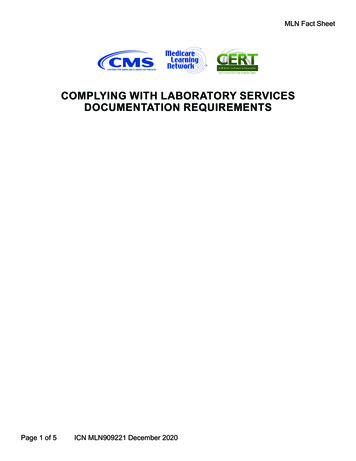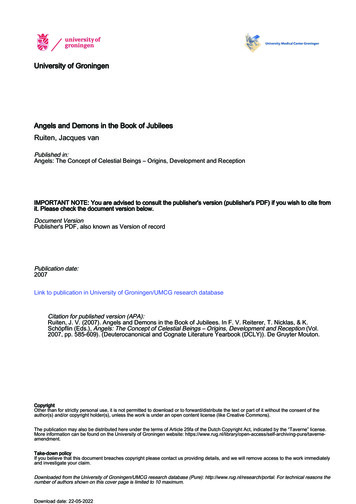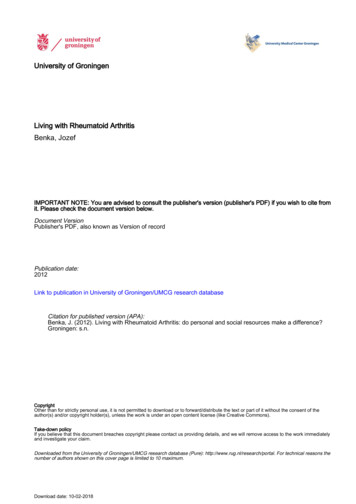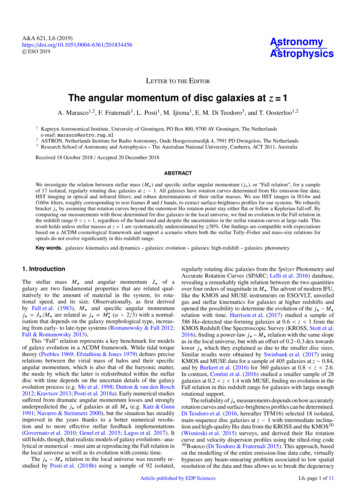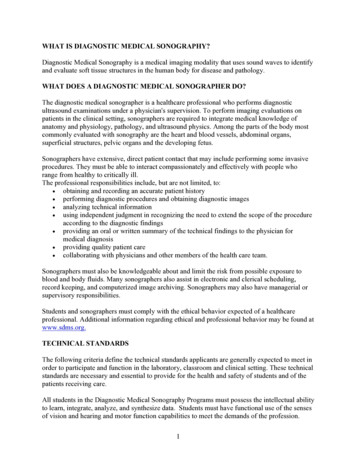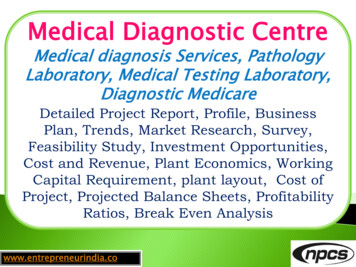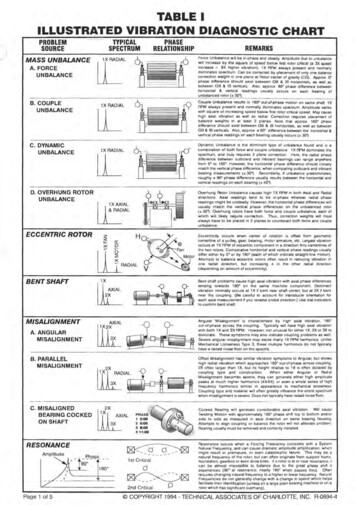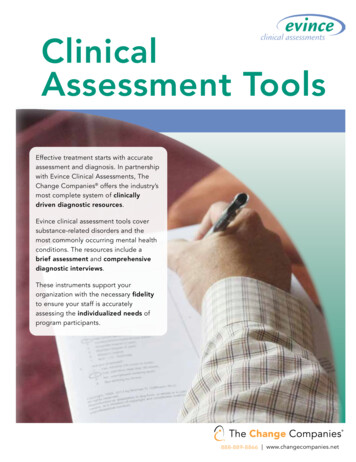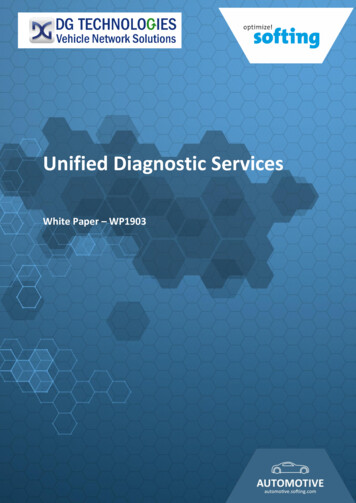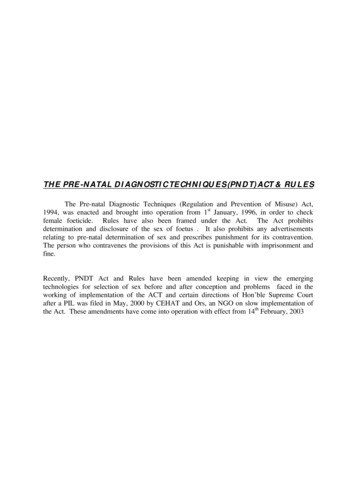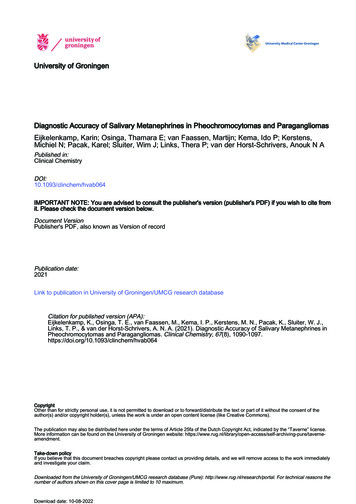
Transcription
University of GroningenDiagnostic Accuracy of Salivary Metanephrines in Pheochromocytomas and ParagangliomasEijkelenkamp, Karin; Osinga, Thamara E; van Faassen, Martijn; Kema, Ido P; Kerstens,Michiel N; Pacak, Karel; Sluiter, Wim J; Links, Thera P; van der Horst-Schrivers, Anouk N APublished in:Clinical ChemistryDOI:10.1093/clinchem/hvab064IMPORTANT NOTE: You are advised to consult the publisher's version (publisher's PDF) if you wish to cite fromit. Please check the document version below.Document VersionPublisher's PDF, also known as Version of recordPublication date:2021Link to publication in University of Groningen/UMCG research databaseCitation for published version (APA):Eijkelenkamp, K., Osinga, T. E., van Faassen, M., Kema, I. P., Kerstens, M. N., Pacak, K., Sluiter, W. J.,Links, T. P., & van der Horst-Schrivers, A. N. A. (2021). Diagnostic Accuracy of Salivary Metanephrines inPheochromocytomas and Paragangliomas. Clinical Chemistry, 67(8), CopyrightOther than for strictly personal use, it is not permitted to download or to forward/distribute the text or part of it without the consent of theauthor(s) and/or copyright holder(s), unless the work is under an open content license (like Creative Commons).The publication may also be distributed here under the terms of Article 25fa of the Dutch Copyright Act, indicated by the “Taverne” license.More information can be found on the University of Groningen website: ing-pure/taverneamendment.Take-down policyIf you believe that this document breaches copyright please contact us providing details, and we will remove access to the work immediatelyand investigate your claim.Downloaded from the University of Groningen/UMCG research database (Pure): http://www.rug.nl/research/portal. For technical reasons thenumber of authors shown on this cover page is limited to 10 maximum.Download date: 10-08-2022
Clinical Chemistry 00:01–8 (2021)Endocrinology and MetabolismKarin Eijkelenkamp,a,* Thamara E. Osinga,a Martijn van Faassen,b Ido P. Kema,b Michiel N. Kerstens,aKarel Pacak,c Wim J. Sluiter,a Thera P. Links,a and Anouk N.A. van der Horst-Schriversa,dMeasurements of plasma free metanephrines are recommended for diagnosing ines can be detected in saliva with LC-MS/MS with sufficient analytical sensitivity and precision.Because collecting saliva is noninvasive and less cumbersome than plasma or urine sampling, we assessed the diagnostic accuracy of salivary metanephrines in diagnosing PPGL.BACKGROUND:This 2-center study included 118 healthyparticipants (44 men; mean age: 33 years (range: 19–74) years))]), 44 patients with PPGL, and 54 patientssuspected of PPGL. Metanephrines were quantified inplasma and saliva using LC-MS/MS. Diagnostic accuracy; correlation between plasma and salivary metanephrines; and potential factors influencing salivarymetanephrines, including age, sex, and posture duringsampling, were assessed.METHODS:RESULTS: Salivary metanephrines were significantlyhigher in patients with PPGL compared with healthyparticipants (metanephrine (MN): 0.19 vs 0.09 nmol/L,P 0.001; normetanephrine (NMN)]: 2.90 vs0.49 nmol/L, P 0.001). The diagnostic sensitivity andspecificity of salivary metanephrines were 89% and87%, respectively. Diagnostic accuracy of salivary metanephrines was 88%, with an area under the ROC curveof 0.880. We found a significant correlation betweenplasma and salivary metanephrines (Pearson correlationcoefficient: MN, 0.86, P 0.001; NMN, 0.83,P 0.001). Salivary NMN concentrations were higherwhen collected in a seated position compared withsupine (P 0.001) and increased with age (P 0.001).CONCLUSIONS: Salivary metanephrines are a promisingtool in the biochemical diagnosis of PPGL. SalivaryaDepartment of Endocrinology and Metabolic Diseases, University of Groningen,University Medical Center Groningen, Groningen, the Netherlands; bDepartment ofLaboratory Medicine, University of Groningen, University Medical Center Groningen,Groningen, the Netherlands; cEunice Kennedy Shriver National Institute of Child Healthand Human Development, National Institutes of Health, Bethesda, MD, USA;dDepartment of Internal Medicine, Division of Endocrinology, Maastricht UniversityMedical Center, Maastricht, the Netherlands.metanephrines correlate with plasma free metanephrinesand are increased in patients with PPGL. At this time,however, salivary metanephrines cannot replace measurement of plasma free metanephrines.IntroductionPheochromocytomas and sympathetic paragangliomasare rare neuroendocrine tumors arising from chromaffincells that can synthesize and secrete catecholamines.Approximately 40% of these tumors are associated withan underlying inherited mutation (1, 2). Early detectionof sympathetic pheochromocytomas and paragangliomas (PPGL) in clinically suspected patients is warrantedto prevent potentially lethal cardiovascular complications. Therefore, screening for PPGL is recommendedfor patients with typical signs and symptoms and/or cardiovascular events, young lean individuals with type 2diabetes, patients with an adrenal incidentaloma, germline mutation carriers, and patients with a previous history or family history of PPGL (3, 4).Measurement of plasma free metanephrines is currently considered to be the most accurate method for diagnosing these tumors, with diagnostic sensitivity andspecificity of 90%–100% and 79%–98%, respectively(3, 5). However, the concentration of plasma free metanephrines can be affected by several factors, includingage, sex, caffeine, medication (e.g., tricyclic antidepressants), salt intake, season, adrenalectomy, smoking,method of sampling, and posture during blood sampling(3, 6–10). Blood sampling in the seated position, for example, can falsely increase plasma metanephrines, withapproximately 30% due to activation of the sympathoadrenal system (7). Therefore, the US Endocrine Societyrecommends letting patients rest in the supine positionfor 20–30 min before blood sampling (3).Consequently,*Address correspondence to this author at: Department of Endocrinology, UniversityMedical Center Groningen, University of Groningen, Hanzeplein 1, 9700 RBGroningen, the Netherlands. Fax þ31-50-3619392; e-mail k.eijkelenkamp@umcg.nl.Received October 16, 2020; accepted March 24, 2021.DOI: 10.1093/clinchem/hvab064C American Association for Clinical Chemistry 2021. All rights reserved. For permissions, please email: journals.permissions@oup.com.V1Downloaded from doi/10.1093/clinchem/hvab064/6294198 by University Library user on 21 July 2021Diagnostic Accuracy of Salivary Metanephrines inPheochromocytomas and Paragangliomas
PARTICIPANTSSPECIMEN COLLECTIONGroup 1 consisted of healthy, normotensive participants(blood pressure 130/80 mmHg without the use ofantihypertensive medication) with a negative history ofcardiovascular events.Patients at the NICHD and UMCG with a confirmed sympathetic PPGL were included in group 2.Patients were eligible for inclusion at the NICHD ifthey were diagnosed with a sympathetic PPGL. Thisdiagnosis was based on increased (according to the reference intervals of the NICHD) plasma free metanephrine(MN) and/or normetanephrine (NMN) collected via anindwelling catheter after 30 min of supine rest (upperreference limit of the NICHD: MN, 0.31 nmol/L;NMN, 0.61 nmol/L). In addition, imaging by computed tomography (CT) or magnetic resonance imaging(MRI) and nuclear imaging had to be compatible withParticipants were asked to not drink caffeine-containingbeverages, to abstain from smoking, and to fast for atleast 1 h before saliva collection. Blood pressure wasmeasured in a seated position using an automated oscillometric device. Saliva was collected using a polyethylene swab (SalivetteV; Starstedt). After that, participantsat the UMCG were placed in the supine position for30 min, and blood was drawn via venipuncture (usingBecton Dickinson VacutainerV tubes containing K2EDTA as an anticoagulant) together with saliva collection in a supine position. At the NICHD, saliva wascollected only in the supine position.MethodsSTUDY DESIGN2 Clinical Chemistry 00:0 (2021)RRANALYTICAL METHODSalivettes were centrifuged at 1000g for 2 min, and thefiltrate was collected and stored at 80 C until analysis.Downloaded from doi/10.1093/clinchem/hvab064/6294198 by University Library user on 21 July 2021This 2-center study was performed at the EuniceKennedy Shriver National Institute of Child Health andHuman Development (NICHD) at the NationalInstitutes of Health (Bethesda, MD, USA) and theUniversity Medical Center Groningen (UMCG;Groningen, the Netherlands).the PPGL diagnosis. In the case of resection of the tumor, the histopathology had to be compatible with thePPGL diagnosis.Patients were eligible for inclusion at the UMCG ifthey were diagnosed with a sympathetic PPGL. Thisdiagnosis was based on increased (according to the reference intervals of the UMCG) plasma free MN and/orNMN collected via direct venipuncture after 30 min ofsupine rest (upper reference limit of the UMCG: MN,0.28 nmol/L; NMN, 0.79 nmol/L) and imaging by CTor MRI and nuclear imaging and, in case of resection ofthe tumor, the histopathology compatible with thePPGL diagnosis.Group 3 consisted of patients suspected of andtested for a sympathetic PPGL (i.e., germline mutationcarriers) and patients with a previous history or familyhistory of PPGL and in whom a PPGL was ruled out.Absence of PPGL was defined as negative CT or MRIstudies and negative results of follow-up biochemicaltesting (i.e., plasma free MN and plasma NMN bothwithin reference range).Exclusion criteria for all 3 groups were asfollows: age 18 years and use of medications thatcould influence plasma free metanephrines, includingtricyclic antidepressants, phenoxybenzamine, monoamine-oxidase inhibitors, sympathomimetics, cocaine,and methyldopa. Patients in group 2 were excludedwhen their histology reports were not compatible witha diagnosis of a PPGL.The study protocol was approved by the medicalethics committee of the UMCG and approved by theInstitutional Review Board of the NICHD (protocol00-CH-0093). All patients provided written informedconsent. Recommendations of the Standards for theReporting of Diagnostic Accuracy Studies werefollowed.these recommendations require determination of reference intervals for plasma free metanephrines in the supine position and special facilities in the hospital forblood sampling, which can be cumbersome and lead toincreased costs (11).Saliva has a potential diagnostic function and offersadvantages over plasma because it can be collected easilyand noninvasively. Saliva contains various enzymes, hormones, and antibodies that enter the saliva from theblood by active and passive diffusion or extracellularultrafiltration. Metanephrines also pass across the acinarcells via ultrafiltration into saliva through gap junctionsbetween cells of secretory units (12). Previously, weshowed that high-performance LC-MS/MS was a highlysensitive technique that enabled the measurement ofvery low concentrations of catecholamines and metanephrines in saliva (13). Because saliva can be collectedat home, specimen collection could also be moreconvenient.The primary aim of this study was to assess thediagnostic accuracy of salivary metanephrines in diagnosing PPGL. Secondary objectives were to assess thecorrelation between plasma and salivary metanephrinesand to evaluate potential influencing factors like sex,age, and posture during sampling on salivarymetanephrines.
Salivary Metanephrinesaccuracy of test performance was defined as the sum oftrue positive and true negative test results over the sumof the number of test results. ROC curves were constructed based on a binary logistic regression model including MN and NMN as covariates. The area underthe curve was calculated to determine the discriminationpower. The difference in test performance was calculated using the method of Hanley and McNeil.After log transformation of the data, a parametriccorrelation analysis (Pearson correlation coefficient) wasused to calculate the correlation between salivary andplasma free metanephrines.To assess several influencing factors on salivarymetanephrines, intra- and intergroup differences wereanalyzed using the Wilcoxon signed-rank test and theMann-Whitney U test. A 1-sided significance level of0.05 was used only to reject the null hypothesis that position during sampling does not influence the concentration of metanephrines.ASSESSMENT OF SHORT-TERM STABILITY OF MN/NMN INSALIVAFor assessment of short-term stability of MN and NMNin saliva, saliva samples from 6 volunteers were used.The saliva samples were divided into aliquots, whichwere stored for periods of 1, 3, 6 and 8 days at 20 C,6 C, and room temperature until storage at 80 Cfor batch sample processing and LC-MS/MS analysis.The control group included aliquots that were stored at 80 C right after obtaining the saliva samples.Repeated-measures ANOVA was used to elucidatechanges and differences in analyte concentrations(Bonferroni correction).STATISTICAL ANALYSISData are presented as mean (SD) or median with interquartile range (IQR), as appropriate. Analyses were performed using SPSS statistics (version 23; IBM/SPSS).Reference intervals for salivary metanephrines wereestablished in the healthy participants. Gaussian distributions of salivary metanephrines were obtained afterlogarithmic transformation of the data. The antilogarithm of the mean (plus or minus 2 SD) of the transformed data was used to obtain the lower and upperreference limits.The diagnostic sensitivity of salivary and plasmametanephrines was calculated from the percentage oftrue-positive over total true-positive plus false-negativetest results in patients with PPGL (group 2). A true positive test result was defined as MN and/or NMN concentrations above the upper reference limit. Diagnosticspecificity was calculated from the percentage of truenegative over the total of true-negative plus false-positivetest results in patients with suspected PPGL and inwhom a PPGL was excluded (group 3). DiagnosticResultsPARTICIPANTSIn group 1, we included 118 healthy participants(44 men and 74 women) with a mean age of 33 years(range: 19 - 74 years).Forty-eight patients with PPGL were eligible for inclusion at the NICHD, and 20 patients with PPGLwere eligible at the UMCG. Twenty-four patients wereexcluded due to the use of interfering medication, missing data, or a pathology diagnosis incompatible withPPGL (Fig. 1). Forty-four patients were included ingroup 2 (24 men and 20 women) with a mean age of 51years (SD: 14 years). Twenty-four patients had sympathetic paraganglioma and 20 patients had pheochromocytoma. Twenty-four patients had metastatic PPGL.Sixty patients tested for PPGL were eligible forinclusion in group 3. Six patients were excluded dueto missing data. In total, 54 patients (23 men and 31women) were included, with a mean age of 46 years(SD: 15.7 years). Fifty patients had a germline mutationin one of the susceptibility genes for PPGL. Fourpatients had a previous history of PPGL. In all patients,a PPGL was ruled out after a median follow-up periodof 4.5 years.The characteristics of the patients in groups 2 and3 are shown in Table 1.SALIVARY MNReference intervals for salivary metanephrines in a supine position were 0.04–0.25 nmol/L for MN and0.20–1.46 nmol/L for NMN (Table 2). Supine salivaryMN concentrations in patients with PPGL, patientswith suspected PPGL, and healthy participants wereClinical Chemistry 00:0 (2021) 3Downloaded from doi/10.1093/clinchem/hvab064/6294198 by University Library user on 21 July 2021Plasma free and salivary metanephrines were analyzedby LC-MS/MS with automatic solid-phase extractionsample preparation (14). All assays were performed inbatches at the Department of Laboratory Medicine ofthe UMCG.The analytical method, extensively validated forplasma free metanephrines, was validated for saliva asdescribed previously, using saliva pools with low, medium, and high concentrations of MN and NMN (13).Intra- and interassay CVs were 1.4%–7.0% and3.2%–8.3%, respectively, for salivary MN 1.7%–1.8%and 1.7%–3.2%, respectively, for salivary NMN. Lowerlimits of quantification in saliva were 0.03 and0.035 nmol/L for MN and NMN, respectively.Recovery was 106% (SD: 10%) for MN and 101%(SD: 5%) for NMN. Linearity was excellent over thedifferent calibration ranges (MN: 0.03–10 nmol/L;NMN: 0.035–26 nmol/L) with R2 0.99 (13).
Table 1. Patient characteristics for groups 2 and 3.Patients withPPGL (n ¼ 44)Patients withsuspectedPPGL (n 5 54)51 (13.9)46 (15.7)Sex (M/F)24/2023/31PCC, n (%)a20 (45)0sPGL, n (%)24 (55)0Metastatic PPGL, n (%)24 (55)0SDHx828RET613Age in years,mean (SD)Germline mutationconfirmed:HIF2a30VHL111NF111MDH210HIF2a, hypoxia-inducible factor-2a; MDH2, malate dehydrogenase 2; NF1,neurofibromatosis; PCC, pheochromocytoma; RET, rearranged during transfection; SDHx, succinate dehydrogenase; sPGL, sympathetic paraganglioma; VHL,von Hippel Lindau.concentrations for patients with PPGL vs healthy participants (P 0.001) and between patients with PPGLvs patients with suspected PPGL (P 0.001). Therewas no statistically significant difference for salivaryMN concentrations between healthy participants vspatients with suspected PPGL (P ¼ 0.726).Supine salivary NMN concentrations in patientswith PPGL, patients with suspected PPGL, and healthyparticipants were 2.90 nmol/L (IQR: 1.54–5.57nmol/L), 0.63 nmol/L (IQR: 0.48–1.08 nmol/L), and0.49 nmol/L (IQR: 0.34–0.71 nmol/L), respectively.There was a statistically significant difference for salivaryNMN concentrations of patients with PPGL vs healthyparticipants (P 0.001) and between patients withPPGL vs patients with suspected PPGL (P 0.001) andbetween patients with suspected PPGL and healthy participants (P 0.001) (Fig. 2).CORRELATION OF PLASMA AND SALIVARY MNWe found a statistically significant correlation between salivary and plasma concentrations of MN andNMN in the supine position (Pearson correlationcoefficient: 0.86 and 0.83, respectively; P 0.001 forboth) (Fig. 3).INFLUENCING FACTORS ON SALIVARY MN IN HEALTHY0.19 nmol/L (IQR: 0.08–1.41 nmol/L), 0.09 nmol/L(IQR: 0.06–0.15 nmol/L), and 0.09 nmol/L (IQR:0.07–0.14 nmol/L; P 0.001), respectively. There wasa statistically significant difference for salivary MN4 Clinical Chemistry 00:0 (2021)PARTICIPANTSSalivary MN collected in the seated position (median:0.09 nmol/L (IQR:0.07–0.13 nmol/L)) was not statistically different compared with salivary MN collectedDownloaded from doi/10.1093/clinchem/hvab064/6294198 by University Library user on 21 July 2021Fig. 1. Flowchart of the inclusion of healthy participants, patients with PPGL, and patients with suspected PPGL.
Salivary MetanephrinesTable 2. Concentrations of salivary metanephrines in healthy participants (n ¼ 118).P valueNMN (nmol/L)P valueSupine0.09 (0.07–0.14)0.3120.49 (0.34–0.71) 0.001Seated0.09 (0.07–0.13)Posture0.62 (0.46–0.86)Age 40 y0.09 (0.06–0.15) 40 y0.10 (0.08–0.15)0.0920.42 (0.32–0.59) 0.0010.63 (0.48–0.95)SexMale0.10 (0.07–0.17)Female0.09 (0.07–0.12)0.0600.55 (0.40–0.82)0.0710.47 (0.33–0.67)Data presented as median and interquartile ranges.Ap 0.001Bp 0.001p 0.726p 0.001p 0.001p 0.001Fig. 2. Concentrations (median and IQR) of salivary MN (A) and NMN (B) in patients with PPGL, patients with suspected PPGL,and healthy participants. The dotted line shows the upper reference limit of salivary MN (0.25 nmol/L) and NMN (1.46 nmol/L).in the supine position (median: 0.09 nmol/L (IQR:0.07–0.14 nmol/L)) (P ¼ 0.312) (Table 2). SalivaryNMN was statistically significant higher in the seatedposition (median: 0.62 nmol/L (IQR:0.46–0.86nmol/L)) compared with collection in the supineposition (median : 0.49 nmol/L (IQR:0.34–0.71nmol/L))) (P 0.001) (Table 2).Salivary MN in healthy participants 40 years(median : 0.09 nmol/L (IQR:0.06–0.15nmol/L)) wasnot statistically different compared with salivary MNClinical Chemistry 00:0 (2021) 5Downloaded from doi/10.1093/clinchem/hvab064/6294198 by University Library user on 21 July 2021MN (nmol/L)
ABSalivary normetanephrine (nmol/L)1000.010.0001.000.100.010Healthy subjectsPatients suspected of PPGLPPGL patientsPPGL patients with negativesalivary (nor)metanephrine100.010.01.0Pearson 0.86p 0.001.001.001.010.1001.00010.000100.000Pearson 0.83p 0.001.1.11.0Plasma metanephrine (nmol/L)10.0100.01000.0Plasma normetanephrine (nmol/L)Fig. 3. Correlation between salivary and plasma MN (A) and NMN (B) concentrations.SHORT-TERM STABILITY MN/NMN IN SALIVAMN and NMN in saliva did not show a significanttime-dependent increase or decrease up to 8 days, evenat room temperature (online Supplemental Fig. 1).However, we did see in one individual a slightly increasing trend for NMN after 3 days at 6 C and room temperature. Consequently, we suggest that the salivashould be sent to the laboratory with cooling packs andwithin 3 days after collection.1.00.8Sensitivityconcentrations of healthy participants 40 years (median : 0.10 nmol/L (IQR:0.08–0.15nmol/L))(P ¼ 0.092). Salivary NMN in healthy participants 40 years (median : 0.63 nmol/L (IQR:0.48–0.95nmol/L)) was statistically higher than in participants 40 years (median : 0.42 nmol/L (IQR:0.32–0.59nmol/L)) (P 0.001).There was a trend, albeit not statistically significant,that salivary MN and NMN concentrations were higher inmen (median: MN, 0.10 nmol/L (IQR:0.07–0.17nmol/L); NMN, 0.55 nmol/L (IQR:0.40–0.82nmol/L)) compared with women (median : MN, 0.09 .33–0.67nmol/L)), respectively (P ¼ 0.060 andP ¼ 0.071).0.60.40.2AUC plasma metanephrines 0.948AUC salivary metanephrines 0.8800.00.00.20.40.60.81.01 - SpecificityFig. 4. ROC curve for salivary and plasma MN in the supineposition, constructed according to logistic regression modelwith a combination of NMN and MN, including patientswith PPGL and patients with suspected PPGL in whom PPGLwas excluded. AUC, area under the curve.DIAGNOSTIC ACCURACY OF SALIVARY AND PLASMA MNThe diagnostic sensitivity of salivary metanephrines inthe supine position was 89% (39/44 patients withPPGL), and diagnostic specificity was 87% (47/54).The diagnostic accuracy of salivary metanephrines in thesupine position was 88% (86/98). The area under theROC curve for combined salivary MN and NMN inthe supine position was 0.880 (Fig. 4). Five of 44patients with PPGL did not have increased supine6 Clinical Chemistry 00:0 pplemental Table 1).Because only patients with PPGL who had increased plasma metanephrines were included, the diagnostic sensitivity of plasma MN was 100%. Thediagnostic specificity of plasma metanephrines was 87%(47/54 patients with PPGL). The area under the ROCcurve for combined plasma MN and NMN in theDownloaded from doi/10.1093/clinchem/hvab064/6294198 by University Library user on 21 July 2021Salivary metanephrine (nmol/L)100.000
Salivary MetanephrinesDiscussionIn this study, we assessed the accuracy of salivary metanephrines measured by LC-MS/MS as an alternative, noninvasive tool in the biochemical diagnosis of PPGL. Weshowed that salivary metanephrines has diagnostic accuracyof 88%, with diagnostic sensitivity of 89% and diagnosticspecificity of 87%. Furthermore, we found a strong correlation between plasma and salivary metanephrines, and theconcentration of salivary metanephrines was significantlyhigher in the group of patients with PPGL than in healthyparticipants. In addition, salivary NMN concentrationswere higher when saliva was collected in the seated positioncompared with supine and increased with age in healthyparticipants.In a previously published study (15), salivary metanephrines was determined in 30 patients with pheochromocytoma and 70 healthy controls, using ELISA. Inagreement with our data, this study found a significantlyhigher concentration of salivary metanephrines inpatients with pheochromocytoma compared withhealthy controls and a strong correlation betweenplasma and salivary metanephrines. The calculated diagnostic sensitivity and specificity of salivary metanephrines for diagnosing pheochromocytoma were both100% . However, the previous study included onlypatients with a pheochromocytoma with plasma concentrations of MN and NMN that were, on average, 9 and4 times higher, respectively, than the values in our studyparticipants. The patients in our study were included in2 tertiary referral centers, and 50% of patients had asympathetic PPGL or metastatic disease.The diagnostic accuracy of plasma metanephrineswas higher than salivary metanephrines, although thedifference was not statistically significant. The lack ofstatistical significance is probably due to the low numberof participants. In the present study, 5 patients hadfalse-negative results for salivary metanephrines. Itshould be noted that 3 patients had only mildly increased plasma metanephrines concentrations. Three ofthe patients with false-negative test results demonstratedvery low concentrations of salivary metanephrines. Thismight be explained by potential preanalytical factors onsalivary metanephrines, such as dilution of saliva due toa high salivary flow rate. Until now, a marker to correctfor this dilution phenomenon is lacking. Next to dilution and influencing factors that are already well knownfor plasma metanephrines, several preanalytical factorsshould be considered when measuring analytes in saliva.Our previous study assessed the influence of the collection device, posture, eating, and awakening response onsalivary metanephrines (13). In line with 2 other studies,patients need proper instructions not to chew on theSalivette, as this will lead to decreased concentrations ofsalivary metanephrines (16, 17).Comparable to plasma free metanephrines, wefound higher salivary NMN, but not MN concentrations, collected in the seated position compared with thesupine position, and this result confirms our previousobservation (13). Patients should be instructed to collecttheir saliva in the supine position.The difference between salivary NMN in the seatedand supine positions but the lack of difference betweensalivary MN in the seated and supine positions might beexplained by the fact that norepinephrine (but not epinephrine) in saliva originates not only from the bloodstream but also from salivary sympathetic nerve endings(17). This locally released norepinephrine adds to themeasured salivary NMN concentration. This phenomenon also explains our finding that the NMN concentration is higher in saliva than plasma. Unfortunately, thisphenomenon might compromise the diagnostic accuracy of salivary metanephrines.For clinical practice, saliva collection offers manyadvantages over plasma or urinary collection, as salivarycollection is noninvasive, inexpensive, and minimallystressful. This makes it potentially suitable for elderlypatients, patients with needle phobia, and children. Inaddition, saliva can be collected at home. Salivary NMNand MN were stable up to 3 days at 6 C and roomtemperature.Our study has some limitations. As mentioned, thediagnostic sensitivity of salivary metanephrines was calculated using a design with participation of consecutivepatients with PPGL who fulfilled our selection criteria,including increased plasma metanephrines as the reference test. A fair comparison between these 2 diagnosticswould require a study with larger sample size, hermore, comparable to plasma free NMN concentrations, we found that higher age was associated withincreased salivary NMN concentrations (18). This suggests that age-adjusted reference intervals for salivaryNMN seem justified. However, the relatively low number of patients in the present study did not allow assessment of such age-adjusted reference intervals. Referenceintervals are also required for children because it has recently been demonstrated that plasma free NMN concentrations show dynamic changes during earlychildhood (19). We did not include patients with hypertension in group 1 to calculate specific reference intervals because another study has shown that, aftermultivariate analysis, the differences between participants who are hypertensive and normotensive are notconsidered to be clinically relevant (6).Clinical Chemistry 00:0 (2021) 7Downloaded from doi/10.1093/clinchem/hvab064/6294198 by University Library user on 21 July 2021supine position was 0.948 (Fig. 4), which was not statistically significantly different compared with salivarymetanephrines (P ¼ 0.086).
Study concept and design: Eijkelenkamp, Osinga, van Faassen, Kema,Kerstens, Sluiter, Links, van der Horst-Schrivers. Acquisition, analysis,or interpretation of data: Eijkelenkamp, Osinga, van Faassen, Kema,Sluiter, Links, van der Horst-Schrivers. Drafting of the manuscript:Eijkelenkamp, van der Horst-Schrivers. Critical revision of the manuscript for important intellectual content: all authors. Administrative,technical, or material support: van Faassen, Kema, Pacak. Final approval of the version to be published: all authors.Supplemental MaterialAuthors’ Disclosures or Potential Conflicts of Interest: Upon manuscript submission, all authors completed the author disclosure form.Wim J. Sluiter’s author disclosure form was completed on his behalf byMichiel N. Kerstens. Disclosures and/or potential conflicts of interest:Supplemental material is available at
Diagnostic Accuracy of Salivary Metanephrines in Pheochromocytomas and Paragangliomas Karin Eijkelenkamp,a,* Thamara E. Osinga,a Martijn van Faassen, bIdo P. Kema, Michiel N. Kerstens,a Karel Pacak,c Wim J. Sluiter, aThera P. Links, and Anouk N.A. van der Horst-Schriversa,d BACKGROUND: Measurements of plasma free metanephr- ines are recommended for diagnosing pheo-
